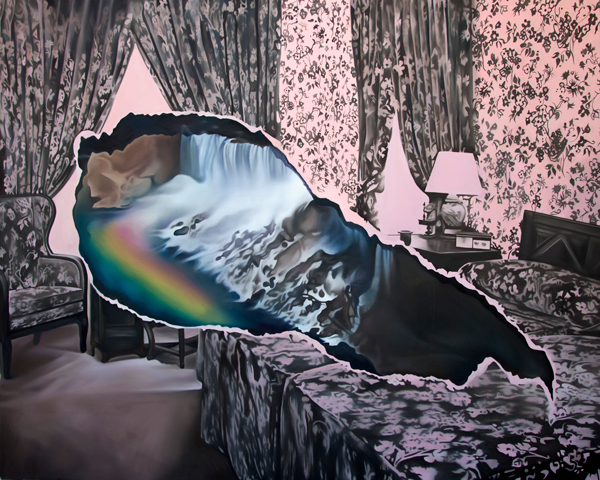On an old oak-lined Pasadena avenue, I’m standing before an imposing wrought-iron gate to a stately Tudor mansion. In dappled afternoon sunlight twinkling beneath breezy treetops, this mysterious setting feels like the beginning of an Alfred Hitchcock movie. Sprawling far beyond, the colossal estate, which I recognize from a video in Ariana Papademetropoulos’ recent show at Wilding Cran Gallery, appears ideal for the studio of an artist engrossed in painting shady facets of elegant domesticity. Before long, Papademetropoulos emerges from up the driveway, greets me cheerily and unlatches the gate.
Just beyond a guesthouse is her brick garage studio. There isn’t much new work inside, for Papademetropoulos has just returned from Europe, where her solo show at Soft Opening in London preceded her residency at Art Athina.
Surrounding an incipient painting propped against a wall, reference photos and tubes of Gamblin oils are scattered about the worn, ornately patterned, paint-splattered floor. Furnishings express Papademetropoulos’ predilection for wacky decor: a vampirish elf lamp, toddler-legged stools, a majestic ram’s head.
Pulling up an obsidian Panton chair for me, she settles into a dainty mauve velvet sofa. This is only our second meeting, but it feels like we’re already friends. She speaks so candidly that some of my questions are answered without having been asked.
“Ever since I was a kid, painting was all I ever did,” she says. Around age 12, the SoCal native briefly considered a career in real estate, as she loves old houses. Instead, she now investigates “the psychology of interior design” through her art. Her lineage is rich with architects of various styles. “I think my interest in how spaces affect us really comes from that background,” she states. “Being around that really made me realize the power of space, the power of installation. That’s why all my paintings reference interiors, and I try to push the limits of interiors and create these environments.”
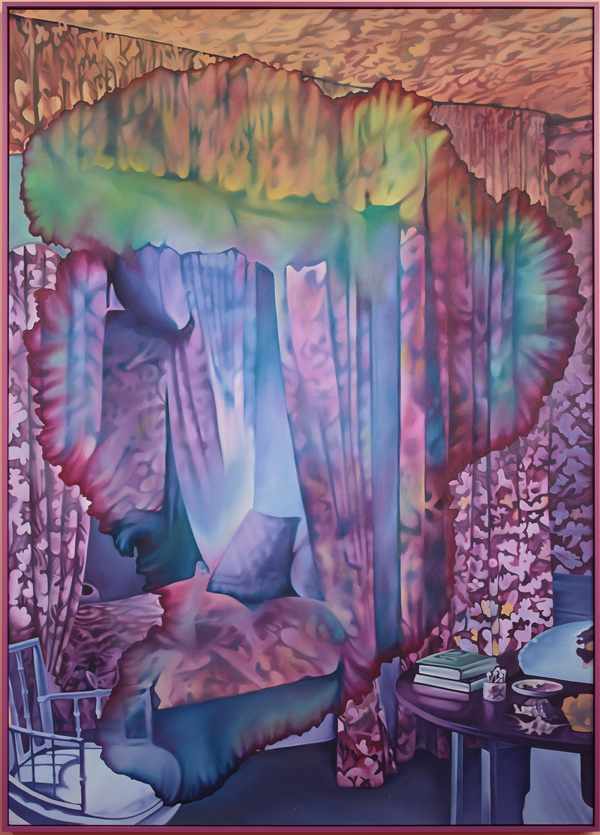
best thing about not dating a scientologist is I can do acid again, 2017
At 17, she found employment acting as a fairy for themed tea parties, which she so enjoyed that she continued for five years. With her elfin mien and flowing dark locks, it’s easy to envision her in character as a “bubble fairy” named Opal Desdemona. Amusingly, she maintained this occupation throughout her time at CalArts. As one of the few students committed to painting, she was rather rebellious; but in order to survive the conceptual program, her paintings’ mystical portent had to remain suppressed. But now, undercurrents of enchantment proliferate in her recent work. Echoes of her fairyhood recur: mermaids peer from deserted atriums; people inhabit symbolic bubbles.
Upon earning her BFA in 2012, she worked as an assistant for numerous artists, including Marnie Weber, Jim Shaw, Noah Davis, Jonah Freeman and Justin Lowe, until her solo debut in 2015.
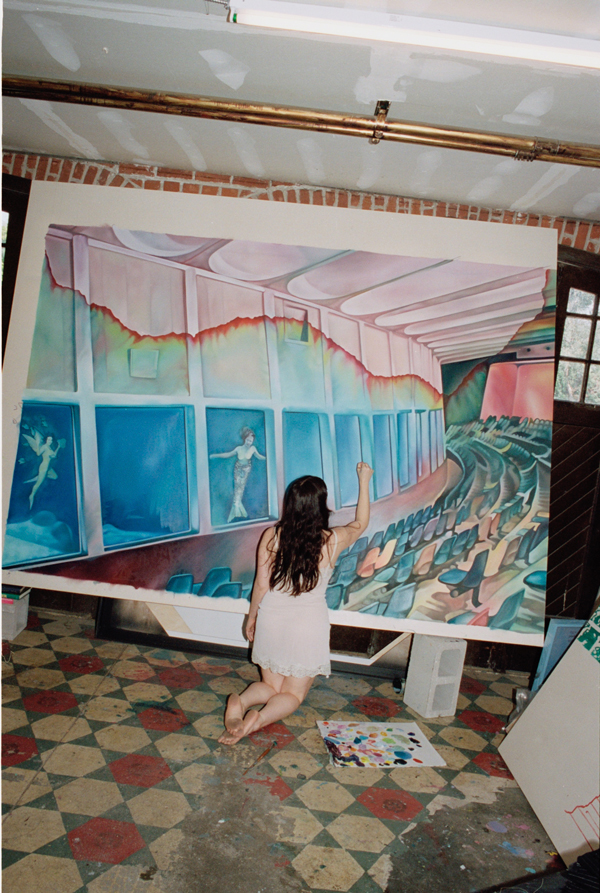
Papademetropoulos painting in her studio
Paintings as Portals
For solo shows, Papademetropoulos devises immersive installations complementing the eerie artifice of her interior paintings where facades of tasteful normalcy liquefy or peel away to betray an otherworldliness beyond.
“I’m very interested in the surface of painting,” she says. “In general, what I was trying to do, always, was make a painting that goes beyond painting.” Each of her paintings is life-sized, inducing the feeling that it could be a real extension of the space it occupies. Most involve some sort of compositional device playing on painting’s flatness. Affirming the picture plane’s window-like status as an alternate way of seeing, her characteristic off-kilter illusionism elaborates dreamy soft-focus scenes.
A current series involves pouring water onto a printed image, photographing it mid-dissolution, then painting from a photo of that disintegrating image. These hallucinogenic water stains convey the notion that something might have spilled on the actual painting, partially destroying the picture’s illusion in order to reassert its two-dimensionality.
“I always wanted to make installations, so for me, dealing with the surface of painting, questioning the surface, makes it a little more interesting than just a painting, if it can be a portal in a way. That’s why I make window paintings or tear paintings—at that moment the painting is a reality because there is a bit of air between the surfaces.”
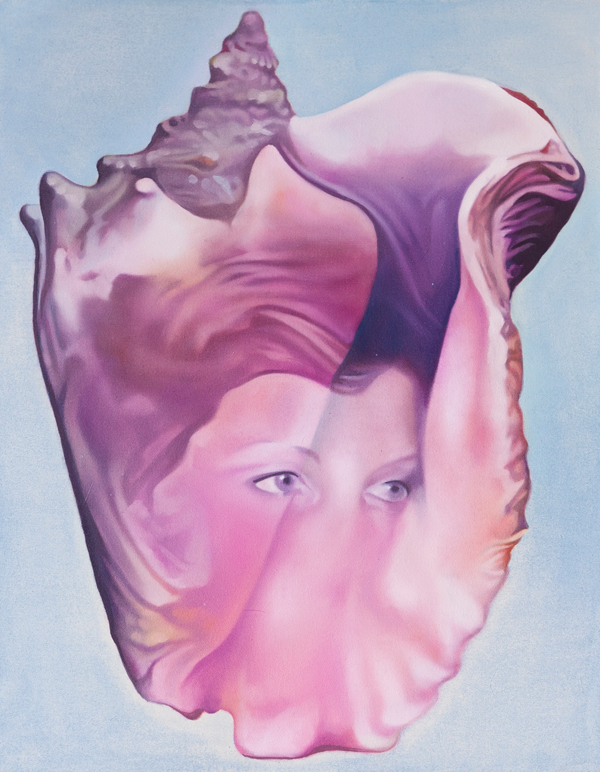
She Sells, 2018, courtesy of the artist and Soft Opening, London
“A lot of my paintings now deal with the indoor-outdoor, a craving for nature,” she tells me. Several new paintings underscore how interior decor mimics patterns in nature, such as do you believe in life after love (2018), where a black-and-white bedroom scene supernaturally tears away like wallpaper to reveal an iridescent cascade underneath. Interlacing nature and artifice, the wavy margins of water stains in I Start Counting (2018) engulf potted blooms and mingle with painted treetops in an opulent mural on walls inside the depicted room. Other new works feature apparitional figures morphing into their surroundings as glass reflections: She Sells (2018) features a woman’s face materializing in a conch before a sky-blue background.
Parallel Worlds
Papademetropoulos’ enchantingly original Instagram feed has nearly 20K followers. Elsewhere, the photogenic artist is frequently pictured posing inside her installations. It leads me to wonder, where does she fit into her work?
“Some people recently thought I was a performance artist, and I just laughed,” she says, “because everything I do on Instagram is for fun.”
Yet she does acknowledge the interrelation between her personality and her art, which she attributes to the force of her esoteric interests leading to serendipitous experiences in bizarre synchronicity with her art. “I feel like I’m living in this parallel world,” she reflects. Her house looks like her paintings; for instance, a campily elegant silk-sheeted bed with swan-shaped bedposts in her Wilding Cran installation, My Hypnotist tells me I’m in a Pink Bubble (2017), ended up inside her actual bedroom.
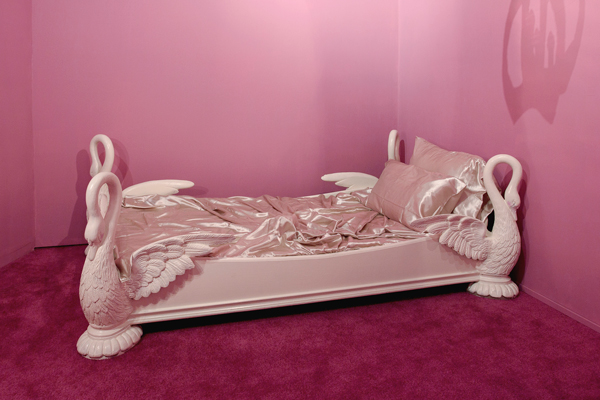
Ariana Papademetropoulos, My Hypnotist tells me I’m in a Pink Bubble (installation detail), 2017.
In art and life, much of Papademetropoulos’ philosophy seems rooted in Baudrillard’s notion of hyperreality; yet her ideas concerning recreational simulacra appear more optimistic than his doom-laden prognostications. She celebrates immersive fantasy’s capacity for providing awe-inspiring experience and implicit sociological insight, merely insinuating the potential for balefulness behind its siren song.
Her face lights up with enthusiasm as she relates a creepy anecdote concerning the recent filming at the guesthouse next to her studio of a TV show featuring Jack Parsons, a semi-occult Pasadena figure who greatly intrigues her. “That’s an example of where something that I’m interested in becomes a kind of version of reality,” she continues. “It’s why I love [Los Angeles] so much. It’s a city built on myth. People come here to make their fantasies reality, and that line gets really blurred: What is fantasy? What is reality? Anything’s possible here; any scenario is possible here. So I end up being in these situations where life is mimicking fantasy, and vice versa.”
Haunted Objects
Papademetropoulos radiates the uncanny aura of inhabiting her own strange but true storybook realm in which she simultaneously operates as author and protagonist, with her paintings as tangible extensions of that world. Recalling the German concept of Gesamtkunstwerk, or “total artwork” comprising art and its environment in complete synthesis, her ideal is to eventually devise all-encompassing installations, perhaps in venerable mansions, of which her paintings would be removable remnants. An auxiliary dream is to someday open a themed bar. “It’s funny, because I have all these ideas, and all I end up doing is—painting!” she observes, chuckling. Like so many modern painters, she has been vexed by the fundamental question: Why paint?
“I never really understood what it means to be a painter until recently; but now I get it. The magic of painting,” she declares, archly pausing to elicit my inquiry.
“I like this theory of famous artists’ work as haunted objects: That person is something, and you want a piece of that,” she expounds. “Sometimes paintings are just beautiful because they’re beautiful, but I like to think of them as extensions of a person in this kind of wizard way… Why would we continue painting, which is so barbaric, unless it possessed this magical power that nothing else could have?”

